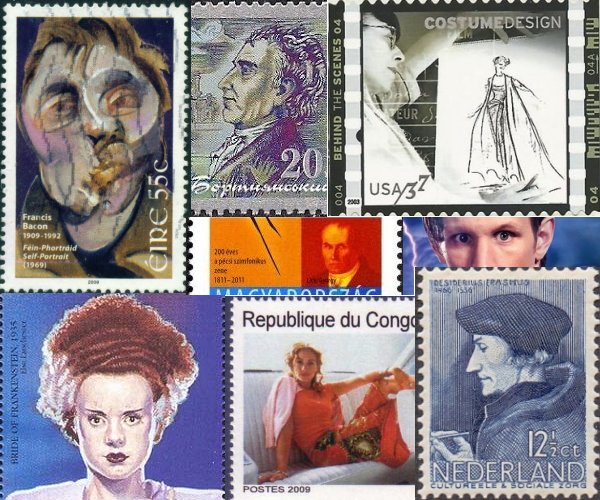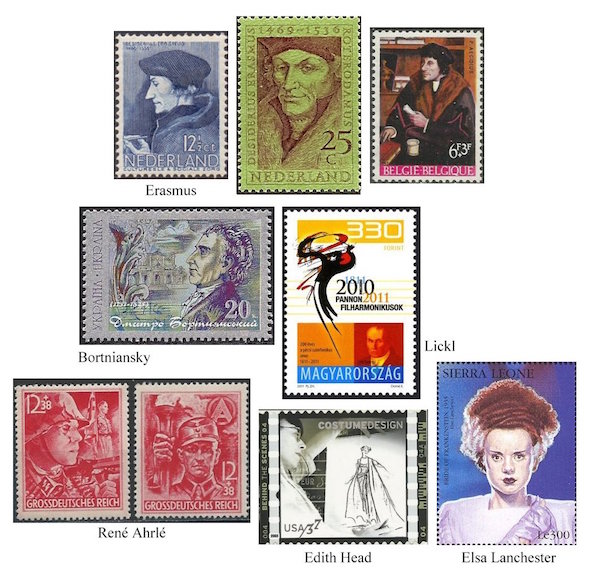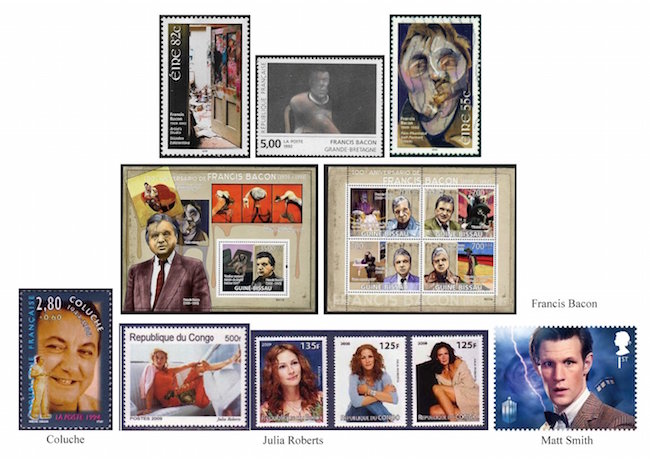The Arts on Stamps of the World — October 28
An Arts Fuse regular feature: the arts on stamps of the world.

By Doug Briscoe
Top billing today must go to Desiderius Erasmus (28 October 1466 – 12 July 1536), not an artist in the strictest sense, but a humanist philosopher and brilliant writer whose most celebrated work is probably his satiric essay In Praise of Folly (1509). He was painted on a number of occasions by Hans Holbein, one of whose portraits was used on a Netherlands Erasmus stamp from 1936. He also sat for Albrecht Dürer (see here and here) and Quentin Matsys (see here).

Dmitri Bortniansky (28 October 1751 – 10 October 1825) was a Ukrainian-born composer best known today almost exclusively for his a cappella choruses for the Russian Orthodox Church, but he also wrote liturgical choruses in French, Italian, Latin, and German, and in his early career composed operas in Italian and French. He had been discovered singing in the local church choir and made such an impression that he went at the age of seven to St. Petersburg, where he sang in the Imperial Chapel Choir under its then director, Baldassare Galuppi. Galuppi took the young man to Italy in 1769, where Bortniansky spent the next ten years, enjoying successes with his three Italian operas. Returning to St. Petersburg, he composed a further four operas in French in addition to some piano sonatas and works in other forms. Eventually he became the first native-born (i.e, from within the Russian Empire) director of the Imperial Choir. His most frequently encountered music today comes from his corpus of 35 choral concertos, a genre that developed in 16th-century Russia. Tchaikovsky edited his liturgical works in 1882. Hey, kids, there’s even a bit of Bortniansky-related Star Trek trivia! The gifted science fiction writer James Blish (1921–1975), a music lover who once wrote a short story about a cloned Richard Strauss, also adapted many episodes of the original Star Trek series as short stories, which were issued in paperback. In one of them, “Whom Gods Destroy” (“I am LORD Garth!”), Blish specifies that Bortniansky’s hymn “Ich bete an die Macht der Liebe” was the theme “to which all Starfleet Academy classes marched to their graduation.”
Carl Georg Lickl was born in Vienna exactly fifty years after Bortniansky (28 October 1801 – 3 August 1877). He was a pianist, flautist, and composer who founded the Pannon Philharmonic of Pécs (pron. PAITCH), then known as the Musical Company, which gave its first concert on December 9, 1811. The 2011 stamp reflects the bicentenary of the orchestra, with Lickl’s portrait thrown in at lower right almost as an afterthought. Lickl wrote sonatas, rondos, and variations for the piano and the physharmonica, which Wikipedia describes as a sort of harmonium, but “differentiated from it by having no stops, being without percussion action, having only a 4 octave compass, and not speaking readily or clearly.” Apparently it was invented by one Anton Haeckl in Vienna in 1818. (Wasn’t there a Hanna–Barbera cartoon called “Haeckl and Lickl”?)
I hesitated before including German graphic artist René Ahrlé (28 October 1893 – 31 March 1976) today, as the only relevant stamps (issued, by the way, on April 21, 1945) celebrate two vicious organizations, the Sturmabteilung and the Schutzstaffel (SA and SS). My reasons for deciding in favor of inclusion are: 1) Ahrlé did much other work during his long life, 2) it gives me the opportunity to mention his son Ferry Ahrlé, also an artist (see below), 3) I’m emboldened by the present administration, and 4) maybe a little controversy will blow up into a cause célèbre and draw many more eyes to The Arts Fuse. Now, about Ferry Ahrlé (born 17 June 1924), he may be of interest to our music-loving readers on account of his portraits of such figures as Wilhelm Furtwängler, Yehudi Menuhin, Otto Klemperer, and Sergiu Celibidache. (Note that the links are to other Arts Fuse pages, not the portraits, which I can’t find online.) Back in the late 40s Ferry Ahrlé designed the covers for two Berlin Philharmonic program books, and Furtwängler appears on one of them. (Who’s that on the other one?) Another couple of music-related works are his drawing of Paul Hindemith and his painting Till Eulenspiegel (2003), specifically referencing the Strauss tone poem.
Two famous women of Hollywood are up next, first Edith Head (October 28, 1897 – October 24, 1981), winner of eight Academy Awards for Best Costume Design. No stamp has been specifically dedicated to her, but her image appears on one from a 2003 sheet saluting the “Behind the Scenes” aspects of American filmmaking. She was born Edith Claire Posener to Jewish parents in San Bernardino. Ironically enough, her father had opened a small haberdashery before she was born, but Edith’s formative years were not at all influenced by it, as the business failed within a year. Reared Catholic after her mother’s second marriage, she was graduated from UC Berkeley in 1919 with honors in French and from Stanford in 1920 with an MA in romance languages. Before working in films she taught French and art, but as early as 1924 she was a costume sketch artist at Paramount, where she would remain for 43 years. Head (she was married twice but retained the name of her first husband Charles Head) was nominated for 35 Oscars (in the period 1948-66 she was nominated every single year) and won more of them than any other woman. Here’s the list: The Heiress (1950), Samson and Delilah (1951), All About Eve (1951), A Place in the Sun (1952), The Greatest Show on Earth (1953), Carrie (also 1953; at this time separate costume awards were given for black and white and color films), Roman Holiday (1954), Sabrina (1955, although most of Audrey Hepburn’s “Parisian” ensembles were designed by Hubert de Givenchy), The Facts of Life (1961), and The Sting (1974).
Five years younger than Edith Head, to the day, was British actress Elsa Lanchester (28 October 1902 – 26 December 1986). As a child she studied dance with Isadora Duncan in Paris. After World War I she founded two organizations, the Children’s Theatre and an artsy nightclub, the Cave of Harmony, where modern plays and cabaret could be seen and where Lanchester herself performed as a singer. She met future husband Charles Laughton in 1927 while they were doing an Arnold Bennett play, and she and Laughton performed often together on stage and in twelve films. (I always assumed their marriage was unconsummated, but Lanchester wrote in her autobiography that she had aborted a fetus sired by Laughton.) H. G. Wells wrote three silent short screenplays for her in 1928. She and Laughton appeared opposite Laurence Olivier in Potiphar’s Wife (1931). The couple removed to Hollywood, where she earned her greatest fame as the Bride of Frankenstein (see the stamp) in 1935. The last time they worked together in a film was in the richly cast Agatha Christie vehicle Witness for the Prosecution (1957), for which they were both nominated for Oscars. Twenty years later she had a role in another star-studded “murder mystery”, this one a delightful (and unsolvable) spoof, Murder by Death (1976).

To begin with, Irish-born painter Francis Bacon (28 October 1909 – 28 April 1992) was indeed a relative, but not a direct descendant, of the other Francis Bacon (1561-1626, the one who wrote all of Shakespeare’s plays; I happen to be reading that other Bacon’s essays at the moment). In the artist’s childhood the family moved back and forth between Ireland and England, and this leads some people to think Bacon’s work reflects his sense of dislocation, among his other fixations. (For a most interesting individual view of Bacon see an in-depth and well-illustrated online piece by Eric Wayne. Another expansive article by Sandra Kisters is here.) Bacon was a rather disreputable fellow before (and a bit after) achieving fame—he skipped out on his rent, was a petty thief, and offered himself to paying gentlemen. The Irish centenary stamps from 2009 include, first, a fresh philatelic take on an artist with a view of his studio, and then his Self-Portrait of 1969. This is a typical Bacon face, essentially cubist but with an element of horror, some of these making me think of the photographs in the movie The Ring. Between these two stamps is one from France showing one of the thirty-odd portraits Bacon made of his close friend and heir (but not lover, though both were gay) John Edwards. The remaining items are two souvenir sheets from Guinea-Bissau that gather together eight Bacon pieces (not seen to good advantage on these low-res scans, but fear not: links follow). On the first one, at upper left, in the tilted frame, is Portrait of Lucian Freud on Orange Couch (1965). Next to that, behind the artist’s head, is the same Self-Portrait seen on the Irish stamp. At upper right on that sheet is the work that helped make Bacon’s name early in his career and one of his numerous triptychs, Three Studies for Figures at the Base of a Crucifixion (1944). He prepared a second version forty years later. The last painting on this sheet is Seated Woman (1961). One the sheet with four stamps are images of Study after Veláquez’s Portrait of Pope Innocent X, (detail, 1953), a work simply called Painting (1946), another Self-Portrait (1973), and Study for a Portrait of Van Gogh V (1957; this is actually one-third of another triptych). Popes, along with crucifixions and screaming mouths with disturbing teeth, are a recurring theme for Bacon, and English composer Mark-Anthony Turnage was inspired by Three Screaming Popes (1951) to compose an eponymous orchestral piece in 1988–89.
Three actors share this October 28 birthday. First born was Michel Gérard Joseph Colucci (28 October 1944 – 19 June 1986), who used the stage name Coluche. Born in Paris not long after the liberation, he was the son of an Italian painter who died of polio when Michel was three. He turned to café singing and then comedy after a decidedly unpromising youth. (He was rather like Francis Bacon in this regard, i.e., trouble with police, as well as in his alchoholism.) Despite bumps along the way (he was fired from two radio stations for using profanity on the air), he continued his career and appeared in his first films in 1973. He won a Best Actor César Award for his work in Claude Berri’s Tchao Pantin (1983). A motorcycle enthusiast, Coluche set a world speed record in 1985 and was killed in a road accident the next year.
I found some unofficial Julia Roberts stamps from the Congo. Georgia-born fifty years ago today, Roberts played clarinet in the school band. After Mystic Pizza (1988) and Pretty Woman (1990), she became the world’s highest-paid actress, a distinction she maintained into the 21st century. Nominated four times for the best actress Oscar, she won in 2000 for Erin Brockovich.
Matthew Robert “Matt” Smith (born 28 October 1982) is, of the dozen actors to portray Doctor Who so far, the one born latest in the year. That means we would today have seen the stamps for all of them if not for the fact that I missed three of these actors in the first two months of the year. (I only discovered the existence of the stamps after the fact. Oops.) Smith is the Eleventh Doctor (2009-13) in the BBC TV series. If you’re not a Doctor Who fan, you may recognize Smith in the role of Prince Philip from the Netflix series The Crown or from numerous other appearances on both the big and small screens.
No stamp yet for Evelyn Waugh (28 October 1903 – 10 April 1966).
A graduate of the University of Massachusetts with a B.A. in English, Doug Briscoe worked in Boston classical music radio, at WCRB, WGBH, and WBUR, for about 25 years, beginning in 1977. He has the curious distinction of having succeeded Robert J. Lurtsema twice, first as host of WGBH’s weekday morning classical music program in 1993, then as host of the weekend program when Robert J.’s health failed in 2000. Doug also wrote liner notes for several of the late Gunther Schuller’s GM Recordings releases as well as program notes for the Boston Classical Orchestra. For the past few years he’s been posting a Facebook “blog” of classical music on stamps of the world, which has now been expanded to encompass all the arts for The Arts Fuse.
